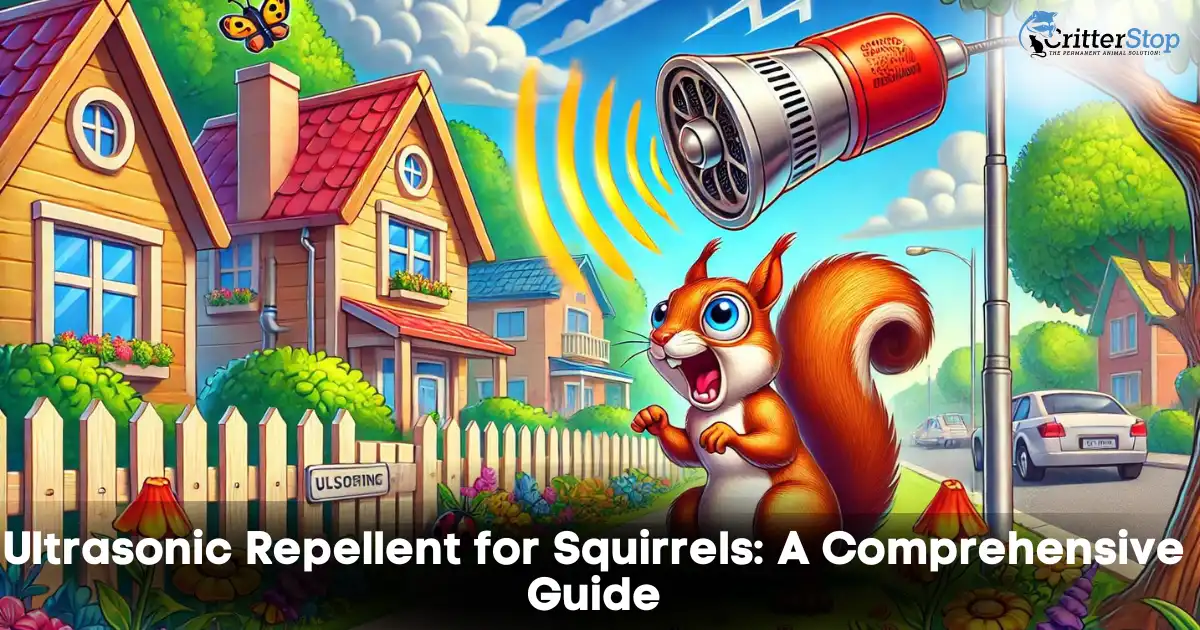
Squirrels, while often charming in their natural habitats, can become a nuisance when they invade our homes, gardens, and properties. They chew through wires, damage insulation, and create noise disturbances. One effective and humane method to deter these persistent critters is the use of ultrasonic repellents. In this detailed guide, we explore the effectiveness, benefits, and considerations of using ultrasonic repellents for squirrels.
Ultrasonic repellents are particularly appealing because they offer a non-lethal, eco-friendly solution that is easy to implement and maintain, making them a preferred choice for many homeowners seeking to protect their properties without causing harm to wildlife.
By combining these modern technologies with expert pest control services, you can ensure a safe and squirrel-free environment.

Ultrasonic repellents are devices that emit high-frequency sound waves, inaudible to humans, but highly disruptive to pests like squirrels. These sound waves create an environment that is uncomfortable for squirrels, encouraging them to vacate the area.
An ultrasonic pest repeller for squirrels is an effective and humane solution for keeping these critters away from your property. These devices emit high-frequency sound waves that are disruptive to squirrels, making the environment uncomfortable and encouraging them to leave. By using an ultrasonic pest repeller, squirrels can be deterred without the need for harmful traps or chemicals, ensuring a safe and eco-friendly approach to pest control.
Ultrasonic repellents work by emitting sound waves at frequencies typically between 20 kHz and 65 kHz. Squirrels, with their sensitive hearing, find these frequencies disturbing, leading them to avoid the area where the repellent is active. These devices often come with variable frequency settings to prevent the pests from becoming accustomed to a single frequency.
The best ultrasonic pest repeller for squirrels would be one that offers a broad frequency range and adjustable settings.
Ultrasonic frequencies from 20 kHz to 65 kHz typically repel squirrels. Devices that can vary within this range are most effective in keeping squirrels away.

One of the primary benefits of ultrasonic repellents is that they provide a humane and non-toxic method of pest control. Unlike traps or poisons, these devices do not harm the squirrels but simply drive them away.
Ultrasonic repellents are generally easy to install and use. Most devices are plug-and-play, requiring no special skills or extensive setup. They can be placed in attics, garages, basements, and other areas where squirrels are likely to invade.
Once installed, ultrasonic repellents require minimal maintenance. They do not need to be replaced frequently and typically come with long-lasting components. Some models even offer solar-powered options, reducing the need for regular battery changes.
Modern ultrasonic repellents often cover a wide area, making them suitable for use in large spaces. This wide coverage ensures that all potential entry points and nesting areas are targeted.
Research on the effectiveness of ultrasonic repellents varies. Some studies have shown positive results, with significant reductions in squirrel activity. However, the effectiveness can depend on various factors such as the size of the area, the number of devices used, and the specific habits of the local squirrel population.
Many users report success in using ultrasonic repellents to deter squirrels. Positive feedback often highlights the immediate reduction in squirrel sightings and the absence of new damage in treated areas.
The effectiveness of ultrasonic repellents can be influenced by:

While ultrasonic repellents offer many benefits, they are not a one-size-fits-all solution. Factors such as building layout and the severity of the infestation can impact their effectiveness. In some cases, additional pest control measures may be necessary.
Ultrasonic devices can sometimes interfere with electronic equipment or be less effective in heavily cluttered areas. It is important to test the device in different locations to find the most effective setup.
Though safe for humans and pets, it is advisable to follow the manufacturer's guidelines to avoid potential interference with medical devices like hearing aids.
When selecting an ultrasonic repellent, consider the following features:
Several brands are known for their reliable ultrasonic repellents:

While ultrasonic repellents are effective, they can be even more powerful when used in conjunction with other squirrel control methods. Here are some complementary strategies:
Physical barriers, such as wire mesh and steel wool, can prevent squirrels from entering your home. These materials can be used to block potential entry points such as vents, chimneys, and gaps around windows and doors.
Modifying the habitat around your property can make it less attractive to squirrels. This includes:
Encouraging natural predators such as owls and hawks can help control the squirrel population. Installing owl boxes or creating a habitat that attracts these predators can naturally reduce squirrel numbers.
Repellent sprays made from natural ingredients like capsaicin (found in hot peppers) can be applied to plants and other areas to deter squirrels. These sprays are safe for plants and humans but create an unpleasant taste and smell for squirrels.
In cases of severe infestation or when other methods fail, it may be necessary to call a professional pest control service. Professionals can provide comprehensive solutions that include:
When selecting a pest control service, consider the following:
Critter Stop is a professional humane wildlife removal company with a fantastic reputation for high-quality work and great customer service. They specialize in humane squirrel removal and provide comprehensive services to ensure your property remains squirrel-free. With numerous positive customer reviews online, Critter Stop is the go-to solution for all your squirrel removal needs.

Conduct regular inspections of your property to identify potential entry points and signs of squirrel activity. Early detection can prevent a small issue from becoming a major infestation.
Implementing regular maintenance practices can keep squirrels at bay:
Educate yourself and others about the habits and behaviors of squirrels. Understanding what attracts them and how they operate can help in developing effective control strategies.
There are several myths surrounding ultrasonic repellents that need clarification:
By understanding and debunking these misconceptions, users can make more informed decisions about using ultrasonic repellents effectively.
Ultrasonic repellents are an eco-friendly option for pest control. They do not use chemicals or poisons, making them safe for the environment.
Most ultrasonic repellents consume minimal energy, especially solar-powered models. This makes them an energy-efficient choice for long-term pest control.
Ultrasonic repellents for squirrels offer a humane, non-toxic, and effective solution for managing squirrel problems. When combined with other pest control methods, they can significantly reduce squirrel activity and prevent future infestations. Regular maintenance, proper installation, and complementary strategies will enhance their effectiveness, ensuring a squirrel-free environment.
Given the significant role squirrels play in ecosystems, it is crucial to address their presence in residential areas humanely and effectively. This is where Critter Stop comes into play. Critter Stop is a professional wildlife removal company with a stellar reputation for high-quality work and excellent customer service.
Their humane methods ensure that squirrels and other wildlife are removed from your property safely and efficiently.
If you are experiencing issues with squirrels or other pests in your home, contact Critter Stop for comprehensive and humane pest control services.
Their expertise and commitment to quality make them the best choice for residential pest control in North Texas.
Contact us at (214) 234-2616 to get a free estimate of our services.
Visit our Critter Library and learn more about our furry friends